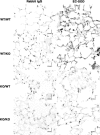Leukocyte-derived extracellular superoxide dismutase does not contribute to airspace EC-SOD after interstitial pulmonary injury
- PMID: 22003088
- PMCID: PMC3774542
- DOI: 10.1152/ajplung.00360.2010
Leukocyte-derived extracellular superoxide dismutase does not contribute to airspace EC-SOD after interstitial pulmonary injury
Abstract
The antioxidant enzyme extracellular superoxide dismutase (EC-SOD) is abundant in the lung and is known to limit inflammation and fibrosis following numerous pulmonary insults. Previous studies have reported a loss of full-length EC-SOD from the pulmonary parenchyma with accumulation of proteolyzed EC-SOD in the airspace after an interstitial lung injury. However, following airspace only inflammation, EC-SOD accumulates in the airspace without a loss from the interstitium, suggesting this antioxidant may be released from an extrapulmonary source. Because leukocytes are known to express EC-SOD and are prevalent in the bronchoalveolar lavage fluid (BALF) after injury, it was hypothesized that these cells may transport and release EC-SOD into airspaces. To test this hypothesis, C57BL/6 wild-type and EC-SOD knockout mice were irradiated and transplanted with bone marrow from either wild-type mice or EC-SOD knockout mice. Bone marrow chimeric mice were then intratracheally treated with asbestos and killed 3 and 7 days later. At both 3 and 7 days following asbestos injury, mice without pulmonary EC-SOD expression but with EC-SOD in infiltrating and resident leukocytes did not have detectable levels of EC-SOD in the airspaces. In addition, leukocyte-derived EC-SOD did not significantly lessen inflammation or early stage fibrosis that resulted from asbestos injury in the lungs. Although it is not influential in the asbestos-induced interstitial lung injury model, EC-SOD is still known to be present in leukocytes and may play an influential role in attenuating pneumonias and other inflammatory diseases.
Figures





Similar articles
-
Inflammatory cells as a source of airspace extracellular superoxide dismutase after pulmonary injury.Am J Respir Cell Mol Biol. 2006 Feb;34(2):226-32. doi: 10.1165/rcmb.2005-0212OC. Epub 2005 Oct 13. Am J Respir Cell Mol Biol. 2006. PMID: 16224105 Free PMC article.
-
Redistribution of pulmonary EC-SOD after exposure to asbestos.J Appl Physiol (1985). 2004 Nov;97(5):2006-13. doi: 10.1152/japplphysiol.00480.2004. Epub 2004 Aug 6. J Appl Physiol (1985). 2004. PMID: 15298984
-
Increased sensitivity to asbestos-induced lung injury in mice lacking extracellular superoxide dismutase.Free Radic Biol Med. 2006 Feb 15;40(4):601-7. doi: 10.1016/j.freeradbiomed.2005.09.030. Epub 2005 Oct 19. Free Radic Biol Med. 2006. PMID: 16458190 Free PMC article.
-
Extracellular superoxide dismutase in pulmonary fibrosis.Antioxid Redox Signal. 2008 Feb;10(2):343-54. doi: 10.1089/ars.2007.1908. Antioxid Redox Signal. 2008. PMID: 17999630 Free PMC article. Review.
-
Mouse extracellular superoxide dismutase: primary structure, tissue-specific gene expression, chromosomal localization, and lung in situ hybridization.Am J Respir Cell Mol Biol. 1997 Oct;17(4):393-403. doi: 10.1165/ajrcmb.17.4.2826. Am J Respir Cell Mol Biol. 1997. PMID: 9376114 Review.
Cited by
-
IL-10 restrains IL-17 to limit lung pathology characteristics following pulmonary infection with Francisella tularensis live vaccine strain.Am J Pathol. 2013 Nov;183(5):1397-1404. doi: 10.1016/j.ajpath.2013.07.008. Epub 2013 Sep 3. Am J Pathol. 2013. PMID: 24007881 Free PMC article.
-
Pulmonary receptor for advanced glycation end-products promotes asthma pathogenesis through IL-33 and accumulation of group 2 innate lymphoid cells.J Allergy Clin Immunol. 2015 Sep;136(3):747-756.e4. doi: 10.1016/j.jaci.2015.03.011. Epub 2015 Apr 28. J Allergy Clin Immunol. 2015. PMID: 25930197 Free PMC article.
References
-
- Adamson IY, Bowden DH. Response of mouse lung to crocidolite asbestos. 2. Pulmonary fibrosis after long fibres. J Pathol 152: 109–117, 1987 - PubMed
-
- Bowler RP, Arcaroli J, Abraham E, Patel M, Chang LY, Crapo JD. Evidence for extracellular superoxide dismutase as a mediator of hemorrhage-induced lung injury. Am J Physiol Lung Cell Mol Physiol 284: L680–L687, 2003 - PubMed
-
- Bowler RP, Arcaroli J, Crapo JD, Ross A, Slot JW, Abraham E. Extracellular superoxide dismutase attenuates lung injury after hemorrhage. Am J Respir Crit Care Med 164: 290–294, 2001 - PubMed
-
- Bowler RP, Nicks M, Tran K, Tanner G, Chang LY, Young SK, Worthen GS. Extracellular superoxide dismutase attenuates lipopolysaccharide-induced neutrophilic inflammation. Am J Respir Cell Mol Biol 31: 432–439, 2004 - PubMed
-
- Bowler RP, Nicks M, Warnick K, Crapo JD. Role of extracellular superoxide dismutase in bleomycin-induced pulmonary fibrosis. Am J Physiol Lung Cell Mol Physiol 282: L719–L726, 2002 - PubMed
Publication types
MeSH terms
Substances
Grants and funding
LinkOut - more resources
Full Text Sources
Medical
Molecular Biology Databases

